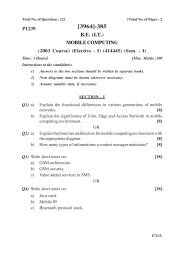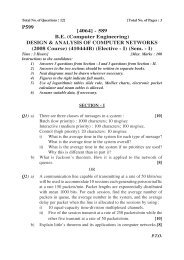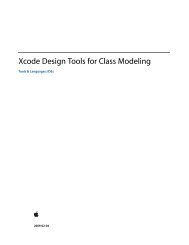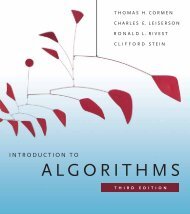Cloud Computing and SOA Convergence in Your Enterprise: A Step ...
Cloud Computing and SOA Convergence in Your Enterprise: A Step ...
Cloud Computing and SOA Convergence in Your Enterprise: A Step ...
Create successful ePaper yourself
Turn your PDF publications into a flip-book with our unique Google optimized e-Paper software.
Information-as-a-Service 47<br />
For <strong>in</strong>stance, the ability for the sales department to do a D&B lookup<br />
while on the phone with a particular customer provides critical customer <strong>in</strong>formation<br />
that will assist <strong>in</strong> clos<strong>in</strong>g a sale <strong>and</strong> prioritiz<strong>in</strong>g sales costs. The<br />
ability to do an <strong>in</strong>stant credit check while complet<strong>in</strong>g a sale, without hav<strong>in</strong>g<br />
to leverage a separate system <strong>and</strong> keep the customer wait<strong>in</strong>g, benefits the<br />
salesperson, the customer, <strong>and</strong> thus the bus<strong>in</strong>ess.<br />
We take a closer look at how to create a bus<strong>in</strong>ess case for cloud comput<strong>in</strong>g<br />
<strong>and</strong> <strong>SOA</strong> us<strong>in</strong>g cloud comput<strong>in</strong>g <strong>in</strong> Chapter 4. The use case described<br />
here is a start<strong>in</strong>g po<strong>in</strong>t for underst<strong>and</strong><strong>in</strong>g the value of cloud comput<strong>in</strong>g versus<br />
on-premise comput<strong>in</strong>g. Of course, the ROI that it will br<strong>in</strong>g to your enterprise<br />
is depends completely on what you do <strong>and</strong> how you do it. The fit for<br />
cloud comput<strong>in</strong>g is not always there, but you always do your analysis with an<br />
open m<strong>in</strong>d.<br />
Why the Most Popular Web APIs, or<br />
Information-as-a-Service Offer<strong>in</strong>gs, Are Free<br />
“You get what you pay for”—but that does not seem to be the case with the<br />
new cloud comput<strong>in</strong>g movement, specifically with Web APIs. Some of the best<br />
services out there do not require a credit card number, <strong>and</strong> that trend will cont<strong>in</strong>ue<br />
until greater numbers of the available Web APIs have normalized. That is<br />
go<strong>in</strong>g to be awhile.<br />
For example, the GeoNames Web API, from geonames.org, is a geographical<br />
database that can be downloaded for free under a creative commons attribution<br />
license. The database conta<strong>in</strong>s over 8 million geographical names <strong>and</strong><br />
provides a broad range of <strong>in</strong>formation on each, from its population <strong>and</strong> form<br />
of government to its topology to its road <strong>and</strong> railway systems <strong>and</strong> more. It conta<strong>in</strong>s<br />
6.3 million unique features, 2.2 million populated places, <strong>and</strong> 1.8 million<br />
alternate names of places.<br />
However, if you do not want to download this data, <strong>and</strong> most of us have<br />
no need to, the data is accessible free of charge through a number of Web Services.<br />
Geonames.org already serves up to over 11 million Web Service requests<br />
per day, <strong>and</strong> all for no subscription fees. There are already over 40 mashups<br />
that leverage this API, as well as those who leverage it for any number of enterprises<br />
or Web applications out there.<br />
cont<strong>in</strong>ued












